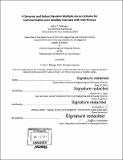| dc.contributor.advisor | Vincent W. S. Chan and Christopher C. Yu. | en_US |
| dc.contributor.author | Metzger, John T. (John Thomas) | en_US |
| dc.contributor.other | Massachusetts Institute of Technology. Department of Electrical Engineering and Computer Science. | en_US |
| dc.date.accessioned | 2016-12-22T16:28:28Z | |
| dc.date.available | 2016-12-22T16:28:28Z | |
| dc.date.copyright | 2016 | en_US |
| dc.date.issued | 2016 | en_US |
| dc.identifier.uri | http://hdl.handle.net/1721.1/106087 | |
| dc.description | Thesis: S.M., Massachusetts Institute of Technology, Department of Electrical Engineering and Computer Science, 2016. | en_US |
| dc.description | Cataloged from PDF version of thesis. | en_US |
| dc.description | Includes bibliographical references (pages 209-210). | en_US |
| dc.description.abstract | SATCOM is a critical capability that is increasingly in demand among civilian and military users. The past several years have seen a dramatic increase in electronic warfare capabilities available to potential adversaries that will pose a significant threat to SATCOM systems. Additionally, the circuit oriented architecture of current SATCOM systems is ill-suited to support future traffic demands and a random multiple-access mode that can dynamically adapt to user traffic, as well as the number of users, will be required for future systems. Given that military operations often take place in contested environments, future systems must also be able to operate in the presence of complex and powerful interference platforms. This thesis proposes a combined system using the slotted ALOHA protocol as its random multiple access scheme along with direct sequence spread spectrum coding to provide channel robustness and low probability of detection. We estimate the transmission power achievable by a transportable interferer using commercially available technologies and develop limits on the maximum channel capacity achievable for different numbers of channels operating in the same frequency band. We show that the combined system can support a large number of channels operating at low data rates when the interferer is present, and higher data rates under benign circumstances. We also investigate the stability of the slotted ALOHA control algorithm under dynamically varying traffic loads and show that the system remains uncongested as long as the average traffic load is kept below the maximum throughput of the channel. The system is shown to be able to return to an uncongested state after periods of time where the traffic load exceeds the maximum throughput of the channel. Two methods for implementing dual-class service are developed and their effects on throughput and latency are discussed. Finally, we anticipate attack strategies an interferer may use to target the physical and media access control layers of the system and develop techniques for mitigating these attacks. A technique known as code switching is developed and shown to significantly improve the system's robustness to attacks targeting both the physical and media access control layers. | en_US |
| dc.description.statementofresponsibility | by John T. Metzger. | en_US |
| dc.format.extent | 210 pages | en_US |
| dc.language.iso | eng | en_US |
| dc.publisher | Massachusetts Institute of Technology | en_US |
| dc.rights | M.I.T. theses are protected by copyright. They may be viewed from this source for any purpose, but reproduction or distribution in any format is prohibited without written permission. See provided URL for inquiries about permission. | en_US |
| dc.rights.uri | http://dspace.mit.edu/handle/1721.1/7582 | en_US |
| dc.subject | Electrical Engineering and Computer Science. | en_US |
| dc.title | A dynamic and robust random multiple-access scheme for communication over satellite channels with interference | en_US |
| dc.type | Thesis | en_US |
| dc.description.degree | S.M. | en_US |
| dc.contributor.department | Massachusetts Institute of Technology. Department of Electrical Engineering and Computer Science | |
| dc.identifier.oclc | 965379765 | en_US |
